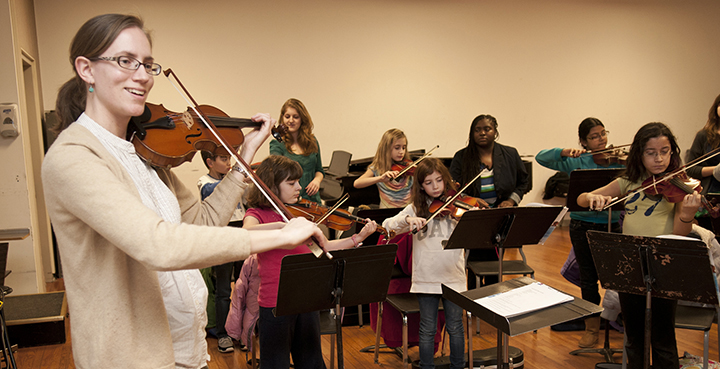Illinois State University String Project master teacher Katherine Lewis leads a class Monday at Cook Hall. Watch this video to see the String Project in action.
A cacophony carried into Cook Hall’s hallways Monday evening as 20 or so students shuffled into a classroom toting instrument cases as large as their third and fourth grade frames.
But the noises weren’t coming from screaming children. No, they were the sounds of the children tuning their string instruments—bass, cello, viola, and violin. Then the class began.
And from the beginning the atonal stretching gave way to the melodious plucking of strings. Master teacher Katherine Lewis engaged the students in a call and response exercise. She played a note, and the students replied in the same note. She asked the class which note they played, and a student answered correctly.
For the next 60 minutes, these beginning students, some as young as 8, received the full attention of Lewis, a doctor of music, and a group of student teachers, who wandered among the students, tuning instruments and giving individual instruction. The entire group—Lewis, the University students, and their young pupils—are part of the String Project, a music education program run by Illinois State University that is offered to local students in the third to eighth grades.
“It’s kind of like a bonus job,” said Lewis, who also serves as a university music professor.
Lewis and String Project Director Adriana Ransom have been running the after-school program for the past seven years. Their hard work recently paid off when the American String Teachers Association selected their program as the 2013 National String Project of the Year and gave Abigail Cash, a senior music education major and cellist, the Student Exemplary Service Award.
“It’s great to be acknowledged on a national level,” Ransom said.
The program works on two levels. It provides affordable string instrument lessons to 115 students who start as beginners before advancing into higher level classes. And it gives hands-on training to college students who want to become music teachers.
The String Project is one of more than 40 such projects across the nation affiliated with the National String Project Consortium. Former Illinois State Professor Kate Hamilton started the University’s program in 2000. Ransom and Lewis have grown the program from about 35 students and four student teachers to a program that regularly attracts 115–120 students and has 22 teachers.
The String Project also provides classes every weekend to rural students at a church in Fairbury. Ransom said those classes helped boost Illinois State’s application for the national award and also offer the student teachers an authentic classroom setting.
Connie Unruh, whose 9-year-old daughter, Lauren, is learning the bass in the beginning class, gushes about the program.
“I think it’s a fantastic opportunity for children,” she said. “The teaching is top-notch.”
Junior Alex Brinkman, who is majoring in music education and cello performance, has been teaching in the program since his freshman year.
“It really kind of inspired me to start teaching,” Brinkman said. “Dr. Lewis has an enthusiasm about teaching that’s contagious.”
Brinkman said the best part is when students have an “aha” moment and finally understand something that they have been working on for weeks.
He also appreciates that the program gives college students four years of practical experience; normally aspiring teachers’ only teaching experience comes in their final semester.
“It gives us an edge,” Brinkman said.
The student teachers gain responsibility with experience, going from being teacher aides to leading their own classes. They are paid but must put in long hours, including on weeknights and weekends, Lewis said.
“I love to see the students step up to the plate,” Lewis said.
The young students must also step to the plate—the classes meet twice a week and students are expected to practice five times a week. Each winter and spring the students dress in orchestra outfits and give recitals in the Center for the Performing Arts.
The String Project attracts homeschoolers and students from 35 area schools, Ransom said.
Misty Metroz, whose son is learning the cello, said the classes are a great opportunity for low-income families.
The classes cost only $75–$85 per semester (depending on the level) compared with $18–$25 per class for the private courses offered in the area, Unruh said. Also, about $2,000 a year is set aside for scholarships for low-income students, Ransom said.
The String Project is funded through its tuition, private donations, and local grants. But the School of Music also makes the program possible by paying Lewis’ and Ransom’s salaries.
That is money well spent if you ask the students. Metroz’s son Xavier said he likes the class because of “all the sounds you make.”
Fourth grader Rachel Simmons explained that she chose the cello because it’s really big and because most everyone else likes to play the violin.
“(The classes are) really fun, and you learn things,” she said.
That is music to any teacher’s ears.
A celebration to mark the String Project’s national award will be held 3 p.m. Saturday, March 23, at the Alumni Center. The event is free and open to the public and will feature music by String Project alumni. For more information about the event, visit Facebook.com/ISUStringProject.



